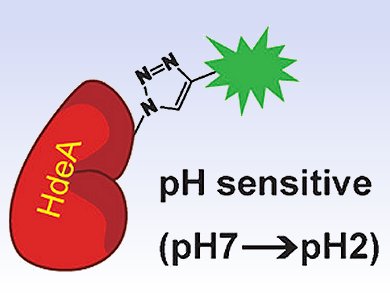Control of cellular pH homeostasis is essential. Changes in intracellular pH gradients are often associated with pathogenic or stressful conditions as well as with resistance to cytotoxic drugs. Nevertheless, measuring extremely low intracellular pH in living cells with protein-based probes remains challenging, since, in very acid environments, these types of sensors undergo denaturation.
A solution to this problem comes from Maiyun Yang and colleagues, Peking University, Beijing, China. The scientists developed a new protein-based pH sensor using E. coli’s pH-responsive acid-chaperone HdeA and 4-N,N-dimethlamino-1,8-naphtalimide, a environment-sensitive fluorophore. By coupling the two, the researchers created a system in which HdeA’s conformational modification following a decrease in pH is converted to a fluorescent change of the dye. Thanks to this new sensor, the researchers could efficiently monitor in living cells, pH changes from 7 to 2.
- Converting a Solvatochromic Fluorophore into a Protein-Based pH Indicator for Extreme Acidity,
M. Yang, Y. Song, M. Zhang, S. Lin, Z. Hao, Y. Liang, D. Zhang, P. R. Chen,
Angew. Chem. Int. Ed. 2012, 51 (31), 7674–7679.
DOI: 10.1002/anie.201204029




